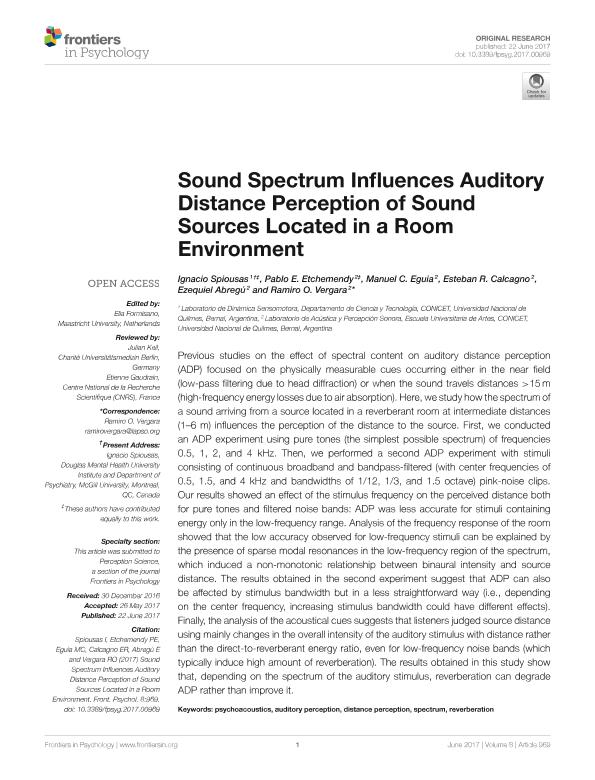Artículo
Sound spectrum influences auditory distance perception of sound sources located in a room environment
Spiousas, Ignacio ; Etchemendy, Pablo Esteban
; Etchemendy, Pablo Esteban ; Eguia, Manuel Camilo
; Eguia, Manuel Camilo ; Calcagno, Esteban
; Calcagno, Esteban ; Abregú, Ezequiel Lucas
; Abregú, Ezequiel Lucas ; Vergara, Ramiro Oscar
; Vergara, Ramiro Oscar
 ; Etchemendy, Pablo Esteban
; Etchemendy, Pablo Esteban ; Eguia, Manuel Camilo
; Eguia, Manuel Camilo ; Calcagno, Esteban
; Calcagno, Esteban ; Abregú, Ezequiel Lucas
; Abregú, Ezequiel Lucas ; Vergara, Ramiro Oscar
; Vergara, Ramiro Oscar
Fecha de publicación:
06/2017
Editorial:
Frontiers
Revista:
Frontiers in Psychology
ISSN:
1664-1078
Idioma:
Inglés
Tipo de recurso:
Artículo publicado
Clasificación temática:
Resumen
Previous studies on the effect of spectral content on auditory distance perception (ADP) focused on the physically measurable cues occurring either in the near field (low-pass filtering due to head diffraction) or when the sound travels distances greater than 15 m (high-frequency energy losses due to air absorption). Here, we study how the spectrum of a sound arriving from a source located in a reverberant room at intermediate distances (1-6 m) influences the perception of the distance to the source. First, we conducted an ADP experiment using pure tones (the simplest possible spectrum) of frequencies 0.5, 1, 2 and 4 kHz. Then, we performed a second ADP experiment with stimuli consisting of continuous bandpass-filtered (with center frequencies of 0.5, 1.5 and 4 kHz and bandwidths of 1/12, 1/3 and 1.5 octave) and broadband pink-noise clips. Our results showed an effect of the stimulus frequency on the perceived distance both for pure tones and filtered noise bands: ADP was less accurate for stimuli containing energy only in the low-frequency range. Analysis of the frequency response of the room showed that the low accuracy observed for low-frequency stimuli can be explained by the presence of sparse modal resonances in the low-frequency region of the spectrum, which induced a non-monotonic relationship between binaural intensity and source distance. The results obtained in the second experiment suggest that ADP can also be affected by stimulus bandwidth but in a less straightforward way (i.e. depending on the center frequency, increasing stimulus bandwidth could have different effects). Finally, the analysis of the acoustical cues suggests that listeners judged source distance using mainly changes in the overall intensity of the auditory stimulus with distance rather than the direct-to-reverberation energy ratio, even for low-frequency noise bands (which typically induce high amount of reverberation). The results obtained in this study show that, depending on the spectrum of the auditory stimulus, reverberation can degrade auditory distance perception rather than improve it.
Archivos asociados
Licencia
Identificadores
Colecciones
Articulos(SEDE CENTRAL)
Articulos de SEDE CENTRAL
Articulos de SEDE CENTRAL
Citación
Spiousas, Ignacio; Etchemendy, Pablo Esteban; Eguia, Manuel Camilo; Calcagno, Esteban; Abregú, Ezequiel Lucas; et al.; Sound spectrum influences auditory distance perception of sound sources located in a room environment; Frontiers; Frontiers in Psychology; 8; JUN; 6-2017; 1-16
Compartir
Altmétricas



